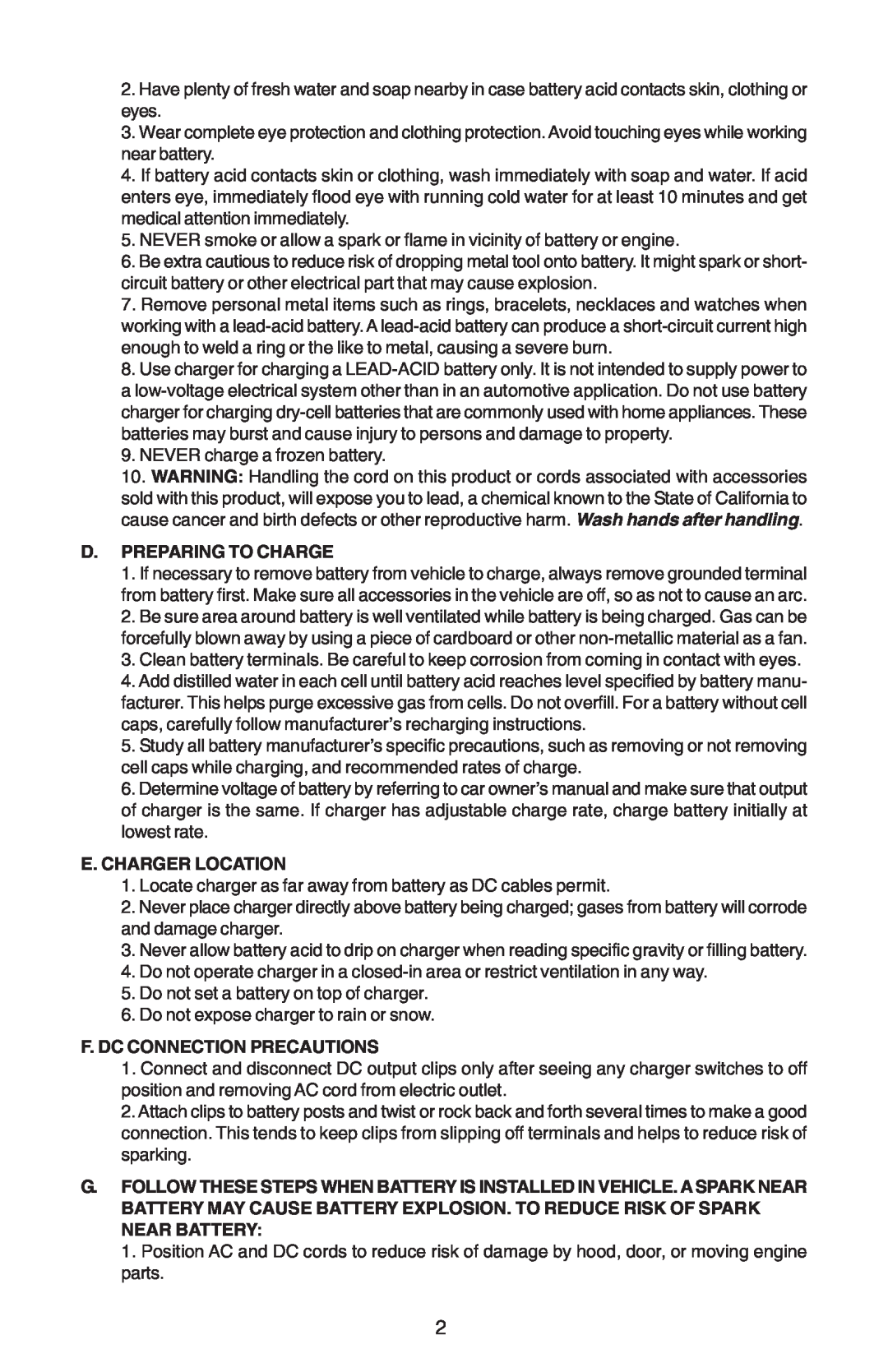2.Have plenty of fresh water and soap nearby in case battery acid contacts skin, clothing or eyes.
3.Wear complete eye protection and clothing protection. Avoid touching eyes while working near battery.
4.If battery acid contacts skin or clothing, wash immediately with soap and water. If acid enters eye, immediately flood eye with running cold water for at least 10 minutes and get medical attention immediately.
5.NEVER smoke or allow a spark or flame in vicinity of battery or engine.
6.Be extra cautious to reduce risk of dropping metal tool onto battery. It might spark or short- circuit battery or other electrical part that may cause explosion.
7.Remove personal metal items such as rings, bracelets, necklaces and watches when working with a
8.Use charger for charging a
9.NEVER charge a frozen battery.
10.WARNING: Handling the cord on this product or cords associated with accessories sold with this product, will expose you to lead, a chemical known to the State of California to cause cancer and birth defects or other reproductive harm. Wash hands after handling.
D.PREPARING TO CHARGE
1.If necessary to remove battery from vehicle to charge, always remove grounded terminal from battery first. Make sure all accessories in the vehicle are off, so as not to cause an arc.
2.Be sure area around battery is well ventilated while battery is being charged. Gas can be forcefully blown away by using a piece of cardboard or other
3.Clean battery terminals. Be careful to keep corrosion from coming in contact with eyes.
4.Add distilled water in each cell until battery acid reaches level specified by battery manu- facturer. This helps purge excessive gas from cells. Do not overfill. For a battery without cell caps, carefully follow manufacturer’s recharging instructions.
5.Study all battery manufacturer’s specific precautions, such as removing or not removing cell caps while charging, and recommended rates of charge.
6.Determine voltage of battery by referring to car owner’s manual and make sure that output of charger is the same. If charger has adjustable charge rate, charge battery initially at lowest rate.
E.CHARGER LOCATION
1.Locate charger as far away from battery as DC cables permit.
2.Never place charger directly above battery being charged; gases from battery will corrode and damage charger.
3.Never allow battery acid to drip on charger when reading specific gravity or filling battery.
4.Do not operate charger in a
5.Do not set a battery on top of charger.
6.Do not expose charger to rain or snow.
F.DC CONNECTION PRECAUTIONS
1.Connect and disconnect DC output clips only after seeing any charger switches to off position and removing AC cord from electric outlet.
2.Attach clips to battery posts and twist or rock back and forth several times to make a good connection. This tends to keep clips from slipping off terminals and helps to reduce risk of sparking.
G.FOLLOW THESE STEPS WHEN BATTERY IS INSTALLED IN VEHICLE. A SPARK NEAR BATTERY MAY CAUSE BATTERY EXPLOSION. TO REDUCE RISK OF SPARK NEAR BATTERY:
1.Position AC and DC cords to reduce risk of damage by hood, door, or moving engine parts.
2
